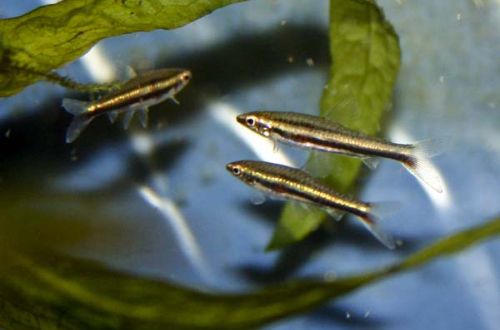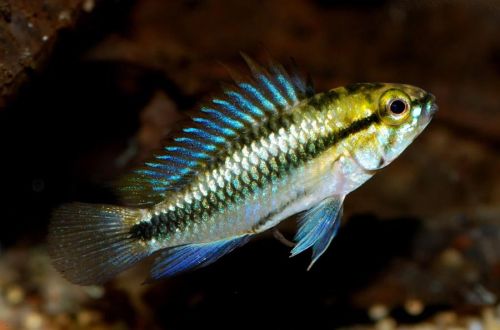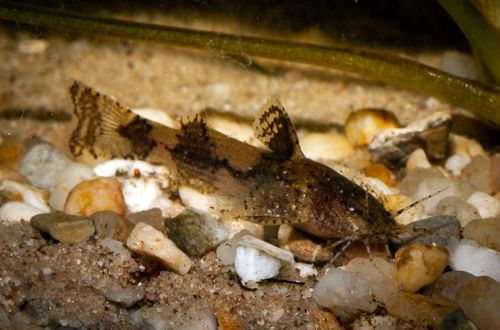
Nannostomus minimus
Nannostomus minimus, scientific name Nannostomus minimus, belongs to the Lebiasinidae family. Rarely seen in the hobby aquarium. As a rule, they are supplied as by-catch in lots with other fish. If this fish gets into a home aquarium, then this will not be a problem. It is easy to maintain and gets along well with species of similar size.

Contents
Habitat
It comes from South America from the Essequibo River basin in Guyana. It inhabits small tributaries and streams, swampy areas characterized by a very slow current or its absence, areas with dense aquatic vegetation, and the water is colored brown due to the abundance of dissolved tannins formed as a result of the decomposition of plant organic matter (branches, tree roots, fallen leaves, etc.).
Brief information:
- The volume of the aquarium – from 40 liters.
- Temperature – 22-28°C
- Value pH — 4.0–6.5
- Water hardness – soft (1-9 dGH)
- Substrate type – any dark
- Lighting – subdued
- Brackish water – no
- Water movement – little or no
- The size of the fish is about 2 cm.
- Meals – any
- Temperament – peaceful
- Keeping a flock of at least 10 individuals
Description
Adult individuals reach a length of about 2 cm. Sexual dimorphism is weakly expressed. Males and females have minor external differences. The main color is gray-brown with red pigmentation on the abdomen and the base of the dorsal and caudal fin.
Food
Omnivorous, accepts most popular flakes, granules, mixtures, etc. of suitable sizes for aquarium fish. Live or frozen foods such as daphnia, brine shrimp can be fed.
Maintenance and care, arrangement of the aquarium
The optimal size of the aquarium for a flock of 10 fish starts from 40-50 liters. The design uses a dark substrate, numerous aquatic plants along with various snags and other natural decor.
Useful design elements are the dried leaves of some trees, placed on top of the ground. This is not only an additional decor, but also a means of giving water the chemical properties characteristic of its natural habitat. The leaves will become a source of tannins formed during the decomposition process. These substances affect such important hydrochemical parameters as pH and dGH.
The maintenance of Nannostomus minimus will not cause great difficulties if you regularly maintain the aquarium, in particular: carry out weekly replacement of part of the water with fresh water, regularly remove organic waste (food residues, excrement), clean design elements and glass from plaque, control the concentration of products of the nitrogen cycle ( ammonia, nitrites, nitrates) and prevent their accumulation.
Behavior and Compatibility
Peaceful timid fish, which should be in the community of their relatives. It is necessary to maintain the size of the group at least 10 individuals, with a smaller number they will become overly shy. Compatible with other non-aggressive species of comparable size.
Breeding / breeding
Under favorable conditions, spawning is not uncommon and a number of fry may reach maturity. However, if targeted breeding is planned, then a more controlled approach is required.
In the home aquarium, the seasonality of reproduction is not expressed. Very often there is a situation when one part of the females came into a spawning state, and the other did not, therefore, in large flocks, numbering dozens of individuals, reproduction occurs constantly. The fish do not lay eggs, but scatter their eggs among thickets of small-leaved plants. To avoid predation by adult fish, all found eggs should be transferred to a separate tank with identical water conditions.
The incubation period lasts 1-2 days. The initial food should be microscopic in size. Infusoria are an ideal choice, but you can also use an alternative – specialized powder products or suspensions for aquarium fish fry.
Fish diseases
Health problems arise only in case of injuries or when kept in unsuitable conditions, which depresses the immune system and, as a result, provokes the occurrence of any disease. In the event of the appearance of the first symptoms, first of all, it is necessary to check the water for the excess of certain indicators or the presence of dangerous concentrations of toxic substances (nitrites, nitrates, ammonium, etc.). If deviations are found, bring all values back to normal and only then proceed with treatment. Read more about symptoms and treatments in the Aquarium Fish Diseases section.





